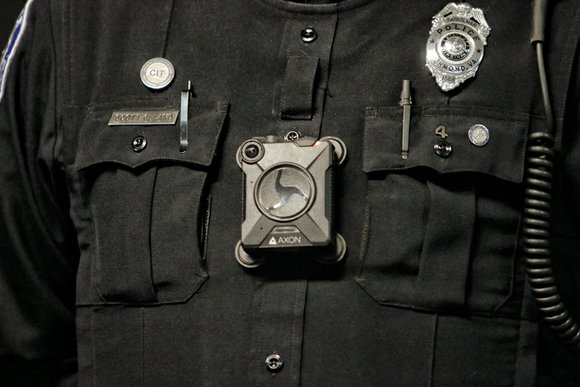Police body cameras arrive
Joey Matthews | 2/5/2016, 7:24 a.m.

“We finally get the chance to tell our story from beginning to end,” Richmond Police Chief Alfred Durham said at a news conference Tuesday announcing the initial deployment this week of 20 body cameras for officers.
Flanked by Mayor Dwight C. Jones, Richmond NAACP President Lynetta Thompson and others, Chief Durham said 20 more body cameras will be issued when they arrive within the next few weeks.
The initial cameras will be used by Richmond officers at the Fourth Precinct in North Side, he said. The plan is to evaluate their use during the next 30 days and to get officers’ feedback before issuing an additional 160 body cameras the department purchased for use this year.
Ultimately, all of Richmond’s nearly 700 police officers are to have body cameras, the chief said.
He said half of the initial cameras are Taser Axon Body 2 cameras that are mounted in the center of the officer’s vest. The other half, Taser Axon Flex cameras, have multiple mounting options.
The move to use body cameras has been hastened in police departments around the country in response to a growing number of highly publicized incidents of police officers killing unarmed black men.
Ms. Thompson has consulted with Chief Durham on the implementation of the body cameras along with Claire Gastañaga, executive director of the Virginia ACLU. Ms. Thompson welcomed the body camera rollout as a means of promoting accountability and trust between law enforcement and the community.
“There are citizens and there are criminals in every community,” she said. “But our concern is when our citizens are being treated as criminals by officers that abuse their authority and have a lack of respect for the people they are entrusted to protect.
“Anytime you put a system or a practice in place that assists in eliminating the perception of mistrust or lowers the opportunity to violate the law, it is a good thing,” she added.
Chief Durham said officers will receive four hours of training in using and operating the cameras before wearing them.
He said officers will start recording with the cameras as soon as a radio call for service is initiated, in a communication from the Department of Emergency Communication on their mobile data terminal in the patrol car or at the beginning of any self-initiated police action.
Officers are required to inform individuals that they are being recorded, the chief said.
He said the body camera would continue to record until the officer has completed his or her report on an incident, at the conclusion of the officer’s involvement in any event, when directed to do so by a supervisor, and in certain areas of medical treatment facilities.
He said department policy does not allow citizens to tell officers that they do not want their interactions recorded.
Recordings are to be classified as evidentiary, non-evidentiary or training, Chief Durham noted. Non-evidentiary recordings will be retained for 90 days, then automatically purged.
All video files will be securely stored in accordance with the records and retention schedule issued by the Library of Virginia, the chief said.
“I am also duty-bound to protect the privacy rights and concerns of all those with whom we interact in instances where the law or the public’s safety requires privacy protections,” Chief Durham said.
“This is all new territory for us and the community, so let us all walk together,” he added.
Chief Durham said he is committed to releasing video “when it does not jeopardize the integrity of an investigation or the privacy rights of victims, witnesses or other involved parties.”






